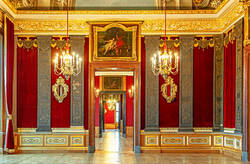The pilasters were also exceptionally beautiful. They are the dividing elements resembling columns that were sewn on to the crimson velvet wall coverings. They give the Audience Chamber its distinctive architectural structure. These glittering gold embroideries had been commissioned by August the Strong and made in Paris a decade earlier.
A system of three-dimensional projecting wall elements in the form of twelve whole and eight half pilasters. It consisted of a sophisticated combination of these magnificent gold embroideries on a gold ground with elaborate gold trim in a range of different designs. The only other known arrangement to compare with this was in Louis the Fourteenth’s throne room at the palace of Versailles. The gold and silver embroidery there was even more monumental.
It may be hard to believe, but most of the gold embroidery and gold trim that was present here in the Audience Chamber in 1719 has survived. Eighty per cent. Because the wall hangings were so precious, people took great care to keep them safe. The entire Audience Chamber was always a place where the memory of Saxony’s heyday under August the Strong was kept alive. In other European countries, embellishments of this kind were generally melted down for their gold and silver content at some point. Here, on the other hand, the many surviving pieces of gold embroidery were crucial to the state room’s reconstruction.
As a result, the Audience Chamber at Dresden’s Residenzschloss is once again a treasure house of the baroque textile arts. Take a close look at the pilasters. In a few individual places, you’ll notice that the gold galloon trim is actually the original. It’s where the trim is tarnished and looks darker. Those areas can no longer be cleaned, because no suitable method has yet been found. As a result, it’s easy to distinguish them from the reconstructed decorations. Once again, allow us to repeat the request: please just look, and don’t touch. You can see how sensitive the materials are.
